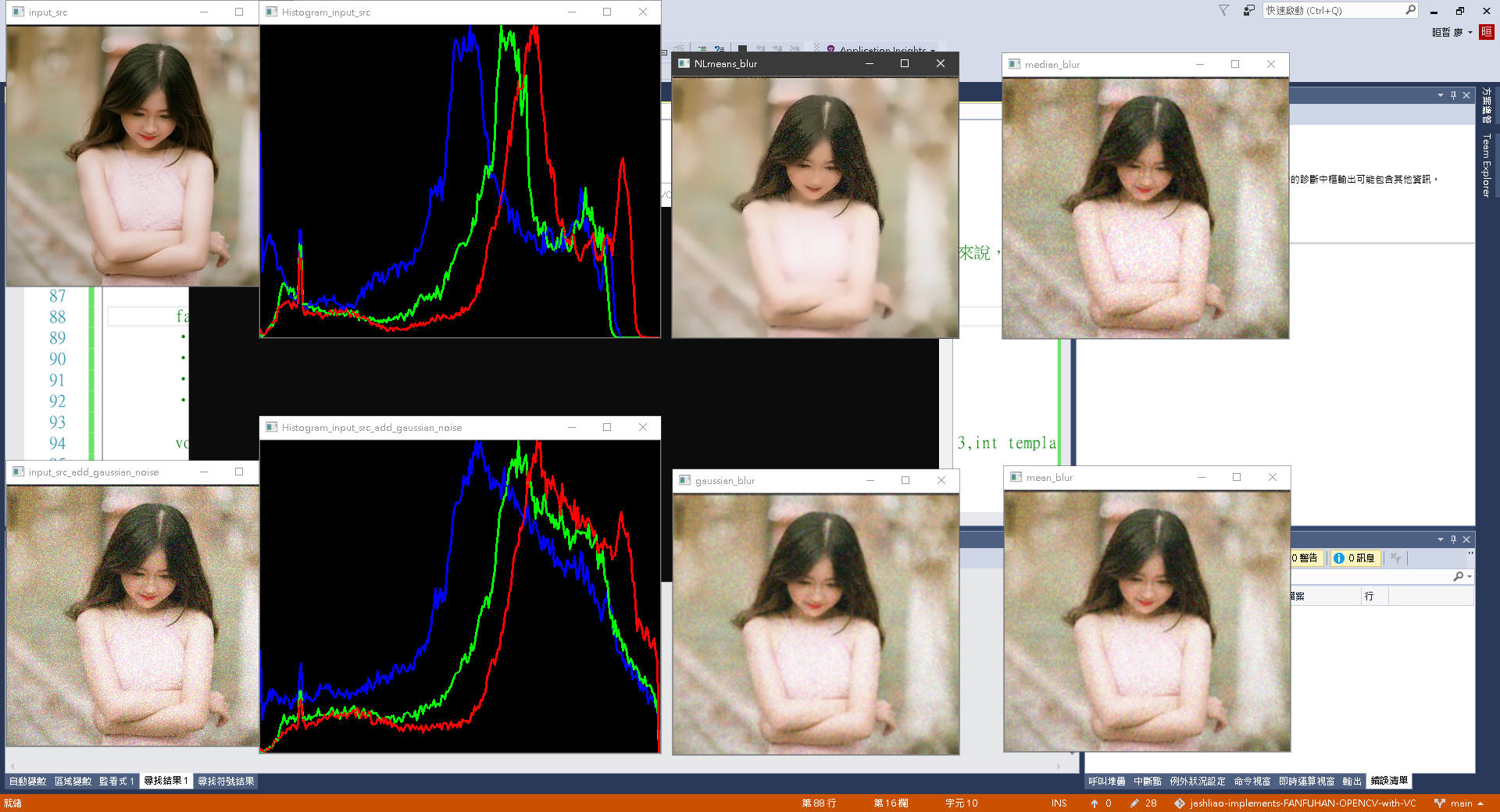jashliao 用 VC++ 實現 fanfuhan OpenCV 教學025 ~ opencv-025-圖像去除雜訊 [均值、高斯、中值、非局部平均(速度慢/效果佳) 濾波器]
jashliao 用 VC++ 實現 fanfuhan OpenCV 教學025 ~ opencv-025-圖像去除雜訊 [均值、高斯、中值、非局部平均(速度慢/效果佳) 濾波器]
資料來源: https://fanfuhan.github.io/
https://fanfuhan.github.io/2019/04/04/opencv-025/
GITHUB:https://github.com/jash-git/fanfuhan_ML_OpenCV
https://github.com/jash-git/jashliao-implements-FANFUHAN-OPENCV-with-VC
★前言:

★主題:
均值去噪聲/雜訊
高斯模糊去噪聲/雜訊
非局部均值去噪聲/雜訊
★C++
// VC_FANFUHAN_OPENCV025.cpp : 定義主控台應用程式的進入點。
//
/*
// Debug | x32
通用屬性
| C/C++
| | 一般
| | 其他 Include 目錄 -> C:\opencv\build\include
|
| 連結器
| |一一般
| | 其他程式庫目錄 -> C:\opencv\build\x64\vc15\lib
|
| |一輸入
| | 其他相依性 -> opencv_world411d.lib;%(AdditionalDependencies)
// Releas | x64
組態屬性
| C/C++
| | 一般
| | 其他 Include 目錄 -> C:\opencv\build\include
|
| 連結器
| |一般
| | 其他程式庫目錄 -> C:\opencv\build\x64\vc15\lib
|
| |一輸入
| | 其他相依性 -> opencv_world411.lib;%(AdditionalDependencies)
*/
#include "stdafx.h"
#include <iostream>
#include <opencv2/opencv.hpp>
#include <opencv2/core/core.hpp>
#include <opencv2/highgui/highgui.hpp>
using namespace std;
using namespace cv;
void showHistogram(InputArray src, cv::String StrTitle);
void backProjection_demo(Mat &mat, Mat &model);
void blur3x3(Mat &src, Mat *det);
void add_salt_pepper_noise(Mat &image);
void add_gaussian_noise(Mat &image);
void pause()
{
printf("Press Enter key to continue...");
fgetc(stdin);
}
int main()
{
Mat src = imread("../../images/test.png");
if (src.empty())
{
cout << "could not load image.." << endl;
pause();
return -1;
}
else
{
imshow("input_src", src);
showHistogram(src, "Histogram_input_src");
// 产生高斯噪声
add_gaussian_noise(src);
imshow("input_src_add_gaussian_noise", src);
showHistogram(src, "Histogram_input_src_add_gaussian_noise");
Mat res1, res2, res3, res4;
// 均值去噪
blur(src, res1, Size(3, 3));
imshow("mean_blur", res1);
// 高斯去噪
GaussianBlur(src, res2, Size(5, 5), 0);
imshow("gaussian_blur", res2);
// 中值去噪
medianBlur(src, res3, 3);
imshow("median_blur", res3);
// NL-Means的全稱是:Non-Local Means,又稱做非局部平均去燥,是利用了整幅圖進行了去燥,所以相對來說,運行時消耗的時間也會更多。
/*
fastNlMeansDenoising相關函數
• fastNlMeansDenoising() - 使用單個灰度圖像
• fastNlMeansDenoisingColored() - 使用彩色圖像。
• fastNlMeansDenoisingMulti() - 用於在短時間內捕獲的圖像序列(灰度圖像)
• fastNlMeansDenoisingColoredMulti() - 與上面相同,但用於彩色圖像。
void fastNlMeansDenoisingColored( InputArray src, OutputArray dst,float h = 3, float hColor = 3,int templateWindowSize = 7, int searchWindowSize = 21
//参数说明:
//src 输入图像
//dst 输出图像
//h 决定过滤器强度。h 值高可以很好的去除噪声,但也会把图像的细节抹去。(取 10 的效果不错)
//hColor 与h相同,使用于彩色图像
//templateWindowSize 奇数。(推荐值为 7)
//searchWindowSize 奇数。(推荐值为 21)
*/
fastNlMeansDenoisingColored(src, res4, 10, 10, 7, 21);
imshow("NLmeans_blur", res4);
waitKey(0);
return 0;
}
return 0;
}
void add_gaussian_noise(Mat &image) {
Mat noise = Mat::zeros(image.size(), image.type());
// 产生高斯噪声
randn(noise, (15, 15, 15), (30, 30, 30));
Mat dst;
add(image, noise, dst);
image = dst.clone();//dst.copyTo(image);//圖像複製
//imshow("gaussian_noise", dst);
}
void add_salt_pepper_noise(Mat &image) {
// 随机数产生器
RNG rng(12345);
for (int i = 0; i < 1000; ++i) {
int x = rng.uniform(0, image.rows);
int y = rng.uniform(0, image.cols);
if (i % 2 == 1) {
image.at<Vec3b>(y, x) = Vec3b(255, 255, 255);
}
else {
image.at<Vec3b>(y, x) = Vec3b(0, 0, 0);
}
}
//imshow("saltp_epper", image);
}
void blur3x3(Mat &src, Mat *det)
{
// 3x3 均值模糊,自定义版本实现
for (int row = 1; row < src.rows - 1; row++) {
for (int col = 1; col < src.cols - 1; col++) {
Vec3b p1 = src.at<Vec3b>(row - 1, col - 1);
Vec3b p2 = src.at<Vec3b>(row - 1, col);
Vec3b p3 = src.at<Vec3b>(row - 1, col + 1);
Vec3b p4 = src.at<Vec3b>(row, col - 1);
Vec3b p5 = src.at<Vec3b>(row, col);
Vec3b p6 = src.at<Vec3b>(row, col + 1);
Vec3b p7 = src.at<Vec3b>(row + 1, col - 1);
Vec3b p8 = src.at<Vec3b>(row + 1, col);
Vec3b p9 = src.at<Vec3b>(row + 1, col + 1);
int b = p1[0] + p2[0] + p3[0] + p4[0] + p5[0] + p6[0] + p7[0] + p8[0] + p9[0];
int g = p1[1] + p2[1] + p3[1] + p4[1] + p5[1] + p6[1] + p7[1] + p8[1] + p9[1];
int r = p1[2] + p2[2] + p3[2] + p4[2] + p5[2] + p6[2] + p7[2] + p8[2] + p9[2];
det->at<Vec3b>(row, col)[0] = saturate_cast<uchar>(b / 9);
det->at<Vec3b>(row, col)[1] = saturate_cast<uchar>(g / 9);
det->at<Vec3b>(row, col)[2] = saturate_cast<uchar>(r / 9);
}
}
}
void backProjection_demo(Mat &image, Mat &model)
{
Mat image_hsv, model_hsv;
cvtColor(image, image_hsv, COLOR_BGR2HSV);//彩色轉HSV
cvtColor(model, model_hsv, COLOR_BGR2HSV);
// 定义直方图参数与属性
int h_bins = 32, s_bins = 32;
int histSize[] = { h_bins, s_bins };//要切分的像素強度值範圍,預設為256。每個channel皆可指定一個範圍。例如,[32,32,32] 表示RGB三個channels皆切分為32區段
float h_ranges[] = { 0, 180 }, s_ranges[] = { 0, 256 };
const float* ranges[] = { h_ranges, s_ranges };
int channels[] = { 0, 1 };
Mat roiHist;//計算ROI的直方圖
calcHist(&model_hsv, 1, channels, Mat(), roiHist, 2, histSize, ranges);
normalize(roiHist, roiHist, 0, 255, NORM_MINMAX, -1, Mat());
Mat roiproj, backproj;
calcBackProject(&image_hsv, 1, channels, roiHist, roiproj, ranges);//使用反向投影 產生ROI(前景)的mask
bitwise_not(roiproj, backproj);//產生背景的mask
imshow("ROIProj", roiproj);
imshow("BackProj", backproj);
}
void showHistogram(InputArray src, cv::String StrTitle)
{
bool blnGray = false;
if (src.channels() == 1)
{
blnGray = true;
}
// 三通道/單通道 直方圖 紀錄陣列
vector<Mat> bgr_plane;
vector<Mat> gray_plane;
// 定义参数变量
const int channels[1] = { 0 };
const int bins[1] = { 256 };
float hranges[2] = { 0, 255 };
const float *ranges[1] = { hranges };
Mat b_hist, g_hist, r_hist, hist;
// 计算三通道直方图
/*
void calcHist( const Mat* images, int nimages,const int* channels, InputArray mask,OutputArray hist, int dims, const int* histSize,const float** ranges, bool uniform=true, bool accumulate=false );
1.輸入的圖像數組
2.輸入數組的個數
3.通道數
4.掩碼
5.直方圖
6.直方圖維度
7.直方圖每個維度的尺寸數組
8.每一維數組的範圍
9.直方圖是否是均勻
10.配置階段不清零
*/
if (blnGray)
{
split(src, gray_plane);
calcHist(&gray_plane[0], 1, 0, Mat(), hist, 1, bins, ranges);
}
else
{
split(src, bgr_plane);
calcHist(&bgr_plane[0], 1, 0, Mat(), b_hist, 1, bins, ranges);
calcHist(&bgr_plane[1], 1, 0, Mat(), g_hist, 1, bins, ranges);
calcHist(&bgr_plane[2], 1, 0, Mat(), r_hist, 1, bins, ranges);
}
/*
* 显示直方图
*/
int hist_w = 512;
int hist_h = 400;
int bin_w = cvRound((double)hist_w / bins[0]);
Mat histImage = Mat::zeros(hist_h, hist_w, CV_8UC3);
// 归一化直方图数据
if (blnGray)
{
normalize(hist, hist, 0, histImage.rows, NORM_MINMAX, -1);
}
else
{
normalize(b_hist, b_hist, 0, histImage.rows, NORM_MINMAX, -1);
normalize(g_hist, g_hist, 0, histImage.rows, NORM_MINMAX, -1);
normalize(r_hist, r_hist, 0, histImage.rows, NORM_MINMAX, -1);
}
// 绘制直方图曲线
for (int i = 1; i < bins[0]; ++i)
{
if (blnGray)
{
line(histImage, Point(bin_w * (i - 1), hist_h - cvRound(hist.at<float>(i - 1))),
Point(bin_w * (i), hist_h - cvRound(hist.at<float>(i))), Scalar(255, 255, 255),
2, 8, 0);
}
else
{
line(histImage, Point(bin_w * (i - 1), hist_h - cvRound(b_hist.at<float>(i - 1))),
Point(bin_w * (i), hist_h - cvRound(b_hist.at<float>(i))), Scalar(255, 0, 0),
2, 8, 0);
line(histImage, Point(bin_w * (i - 1), hist_h - cvRound(g_hist.at<float>(i - 1))),
Point(bin_w * (i), hist_h - cvRound(g_hist.at<float>(i))), Scalar(0, 255, 0),
2, 8, 0);
line(histImage, Point(bin_w * (i - 1), hist_h - cvRound(r_hist.at<float>(i - 1))),
Point(bin_w * (i), hist_h - cvRound(r_hist.at<float>(i))), Scalar(0, 0, 255),
2, 8, 0);
}
}
imshow(StrTitle, histImage);
}
★Python
import cv2 as cv
import numpy as np
def gaussian_noise(image):
noise = np.zeros(image.shape, image.dtype)
m = (15, 15, 15)
s = (30, 30, 30)
cv.randn(noise, m, s)
dst = cv.add(image, noise)
cv.imshow("gaussian noise", dst)
return dst
src = cv.imread("D:\\code-workspace\\Clion-workspace\\learnOpencv\\images\\test.png")
cv.imshow("input", src)
h, w = src.shape[:2]
src = gaussian_noise(src)
result1 = cv.blur(src, (5, 5))
cv.imshow("mean_blur", result1)
result2 = cv.GaussianBlur(src, (5, 5), 0)
cv.imshow("gaussian_blur", result2)
result3 = cv.medianBlur(src, 5)
cv.imshow("median_blur", result3)
result4 = cv.fastNlMeansDenoisingColored(src, None, 15, 15, 10, 30)
cv.imshow("NLmeans_blur", result4)
cv.waitKey(0)
cv.destroyAllWindows()
★結果圖:

★延伸說明/重點回顧: